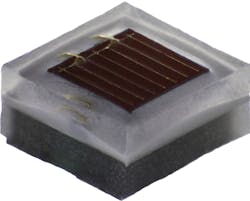Cree upgrades color LED family to SC5 technology and adds new optic
The low-profile primary optic and the SC5 technology platform behind the XLamp XQ-E High Intensity color LED family will serve applications such as façade lighting.
Cree has announced an upgraded XLamp XQ-E packaged LED product family applying its High Intensity (HI) feature set to color LEDs and a new white LED. The new products are based on the SC5 (silicon carbide 5) technology platform and are offered in white, red, red-orange, phosphor-converted amber, green, blue, and royal-blue versions for solid-state lighting (SSL) applications such as architectural façade lighting.
Interested in more articles & announcements on packaged LEDs?
Ironically, the Cree announcement came just after a feature article on color LEDs was ready for the printer. Watch for that article in our October issue, although these Cree products will not be covered in depth due to the timing. Still, the Cree color LEDs fit in the same façade, signage/display, automotive, and other applications covered in depth in the October article.
The new Cree XQ-E HI white LEDs deliver 334 lm at 1A of drive current and 3W. The original XQ-E family was launched back in 2013 based on the SC3 platform. And the original XQ-E white LED delivered 287 lm.
Left to right: Cree's XQ-EHI White LED and XQ-EHI-BGROY and XQ-EHI-RRO color LEDs, respectively.
Still, the performance improvement is more significant than evident strictly from a luminous flux comparison. The HI concept came to market earlier this year in the XP-L product family. The LEDs use a relatively flat primary optic that ultimately enables a tighter beam and better punch or center beam candle power (CBCP).
The advantage of the primary optic comes into play when you pair the LED with a secondary optic. Cree said in the case of XQ-E, the secondary optic would essentially see a source size that was 50% as large as what the original XQ-E LEDs would have produced. The result is focus of the flux in the tighter beam.
Lumileds has made similar claims regarding the color LEDs in the Luxeon C family launched early in September. Those LEDs use a low-profile dome that is far flatter than the hemispherical primary optic often used on packaged LEDs.
The Cree LEDs come in a smaller 1.6×1.6-mm form factor relative to the 2×2-mm Lumileds Luxeon C family. Still, based on a look at the Luxeon C datasheet, it appears that the Luxeon C white offering would be in the 310-lm range. The slightly smaller footprint of the XQ-E LEDs would also enable more dense packing of the LEDs in a luminaire.
Lumenpulse is one company that uses color LEDs in luminaires intended for façade or grazing applications, and that commented on the new Cree products. "The XQ-E High Intensity is a perfect tool in our toolkit to maximize candela output for our innovative products," said Greg Campbell, senior vice president and CTO at Lumenpulse. He further emphasized the importance of CBCP, adding, "At Lumenpulse, candela is the name of the game, and we want to put as much light as possible on the surface we are illuminating, as efficiently as possible."

Maury Wright | Editor in Chief
Maury Wright is an electronics engineer turned technology journalist, who has focused specifically on the LED & Lighting industry for the past decade. Wright first wrote for LEDs Magazine as a contractor in 2010, and took over as Editor-in-Chief in 2012. He has broad experience in technology areas ranging from microprocessors to digital media to wireless networks that he gained over 30 years in the trade press. Wright has experience running global editorial operations, such as during his tenure as worldwide editorial director of EDN Magazine, and has been instrumental in launching publication websites going back to the earliest days of the Internet. Wright has won numerous industry awards, including multiple ASBPE national awards for B2B journalism excellence, and has received finalist recognition for LEDs Magazine in the FOLIO Eddie Awards. He received a BS in electrical engineering from Auburn University.







